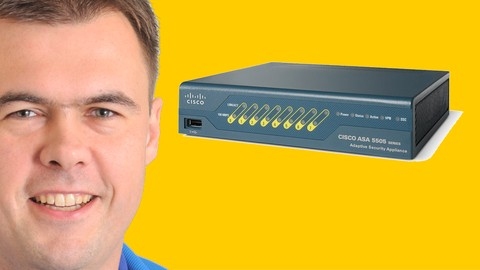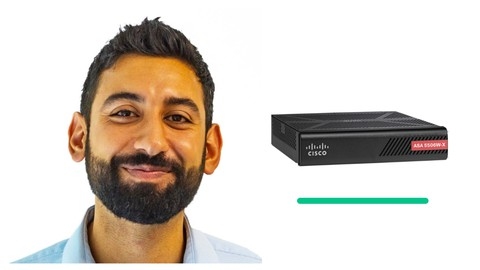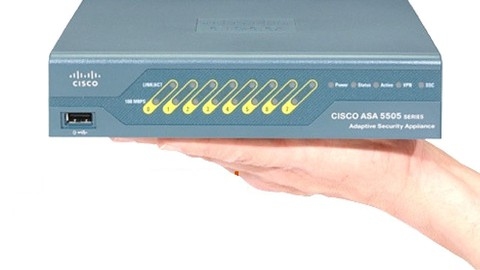Cisco ASA (Adaptive Security Appliances) firewalls are powerful devices that protect networks from threats.
Mastering their configuration is essential for any network administrator or security professional, as it enables you to implement robust security policies, control traffic flow, and ensure network uptime.
Learning about Cisco ASA firewalls can open doors to rewarding careers in network security and help you build a strong foundation for advanced cybersecurity skills.
Finding a good Cisco ASA course on Udemy can be a challenge.
There are many options available, but you need a program that’s comprehensive, engaging, and taught by experts.
You want a course that goes beyond theory and provides practical experience and hands-on projects to solidify your understanding.
We’ve reviewed countless courses and based on our analysis, Cisco ASA firewall basics is the best course on Udemy overall.
This course stands out for its comprehensive coverage of essential topics, including access lists, Network Address Translation (NAT), management access, and ASDM (Adaptive Security Device Manager).
It also includes a hands-on lab environment where you can practice real-world scenarios.
This is just the tip of the iceberg when it comes to quality Cisco ASA courses on Udemy.
We have a variety of options available depending on your learning style and experience level, as well as courses focused on specific topics like VPN configuration, troubleshooting, and advanced security features.
Keep reading to discover our full list of recommendations and find the perfect Cisco ASA course to take your network security expertise to the next level.
Cisco ASA firewall basics
The course starts by introducing you to the different ASA hardware models and their configurations.
You’ll learn about interfaces, switchports, and how to set up security levels for different network segments.
One of the key focuses is on access lists.
The course dives deep into implementing access lists, covering both parts 1 and 2.
This is crucial for controlling traffic flow through the firewall.
You’ll also get hands-on experience with the course lab environment, which allows you to practice real-world scenarios.
Network Address Translation (NAT) is another major topic covered extensively.
The course walks you through the different types of NAT, including static, dynamic, and policy NAT.
You’ll learn how to configure NAT rules step-by-step.
Management access is another important aspect, and the course covers both parts 1 and 2, ensuring you can securely manage your ASA firewall.
The course also teaches you how to set up the ASA as a local DHCP server, which can be handy in certain environments.
Additionally, you’ll get an introduction to ASDM (Adaptive Security Device Manager), the graphical user interface for managing ASA firewalls.
This is covered in two parts, giving you a comprehensive understanding of the tool.
Towards the end, there’s a live configuration demo, where you can see the entire process of setting up an ASA firewall from scratch.
Cisco ASA Firewall Fundamentals
You’ll start with the fundamentals, learning about packet tracer and the differences between stateful and stateless firewalls.
From there, you’ll dive into the ASA itself, with modules on initial setup, interface security levels, access-lists, and NAT configuration.
One key aspect is the coverage of different ASA deployment modes, like routed and transparent mode.
You’ll also learn about security contexts, which allow you to consolidate multiple firewalls into a single device.
The modular policy framework (MPF) is another important topic, showing you how to simplify and centralize policy management across multiple security services.
And speaking of services, the course explores the ASA’s high availability capabilities for maximizing uptime.
When it comes to security features, you’ll get hands-on with firewall services like intrusion prevention and malware protection.
But the course goes beyond just firewalling, with dedicated sections on VPN concepts, remote access VPN setup, and site-to-site VPN configuration using the ASA.
Whether you’re a networking professional or just starting out, the well-rounded curriculum makes it an excellent choice.
Implementing a Cisco ASA Firewall 9.X - All - in - One
The course starts with an overview of the ASA and how traffic flows through it.
You’ll learn how to perform basic initialization and configure routing protocols like static routes, RIPv2, EIGRP, OSPF, and BGP on the ASA.
Moving on, you’ll dive into controlling traffic using access control lists (ACLs) and configuring management access using Telnet, SSH, and the ASDM.
Network Address Translation (NAT) is a crucial topic, and the course covers dynamic NAT, static NAT, destination NAT, dynamic PAT, static PAT, and policy NAT in detail.
The course also covers the transparent firewall mode, which operates at Layer 2.
You’ll learn about initializing a transparent firewall, routing through it, and using Ethertype ACLs.
Virtualization and redundancy are essential for enterprise deployments, so the course covers security contexts, redundant interfaces, port channels, active/standby failover, active/active failover, and ASA clustering in both spanned and individual modes.
Deep packet inspection is a powerful feature of the ASA, and the course covers the Modular Policy Framework (MPF) for deep inspection, including examples with ICMP and non-standard ports.
Virtual Private Networks (VPNs) are also covered, with topics like IPsec overview, configuring LAN-to-LAN VPNs using crypto maps, NAT-T, and remote access VPNs using AnyConnect.
You’ll also learn how to configure ASDM for management and set up a web VPN.
Cisco ASA AnyConnect VPN
You’ll start by understanding the difference between IPSec and AnyConnect VPN clients, and then move on to the basic setup process.
You’ll learn how to download the necessary AnyConnect files from Cisco.com and upload them to the ASA firewall.
The course covers the use of SSL certificates and the ASDM (Adaptive Security Device Manager) interface for managing the ASA.
You’ll configure the AnyConnect package files, enable AnyConnect on the ASA, and troubleshoot any issues with logging and debugging.
Once the basic setup is complete, you’ll learn how to connect to the VPN for the first time and fix any NAT (Network Address Translation) issues that may prevent the VPN from working correctly.
The course then dives into advanced features like split tunneling, allowing users to select connection profiles, and configuring VPN filters.
One of the key topics covered is the Client Profile Editor, which allows you to customize the AnyConnect client settings.
You’ll also learn how to authenticate users using LDAP (Lightweight Directory Access Protocol) and implement Dynamic Access Policies for granular control over VPN access.
Throughout the course, you’ll work in a lab environment, ensuring you gain practical experience with the concepts being taught.
Cisco ASA Firewall Training
The course starts with an introduction to the ASA firewall and a basic lab to get you familiar with the environment.
You’ll learn how to permit ICMP traffic and configure static routing, which are fundamental networking skills.
From there, you’ll dive into the core features of the ASA, including enabling Telnet and SSH access, configuring interface and global ACLs, working with object-groups and objects, and understanding the active standby failover process.
The course also covers the transparent mode of the ASA firewall, including multiple bridge groups.
Routing protocols like OSPF and EIGRP are covered, equipping you with the knowledge to integrate the ASA into larger network environments.
You’ll also learn about redundant interfaces, a crucial aspect of high availability.
A significant portion of the course is dedicated to NAT (Network Address Translation), covering static NAT, static PAT, dynamic NAT, dynamic PAT, and destination NAT.
Both auto and manual NAT configurations are explored, giving you a well-rounded understanding of this essential feature.
To prepare you for interviews, the course includes a section with ASA firewall interview questions and answers.
Additionally, you’ll learn how to install and integrate GNS3 and the ASAv (ASA Virtual) image, allowing you to practice in a virtual environment.
Cisco ASA Firewall in 12 days
You’ll start by setting up the ASAv (Cisco’s virtual ASA) and a router on GNS3, a popular network simulation software.
The course then dives into the fundamentals of the ASA, including basic routing and redistribution.
A significant portion of the course is dedicated to Network Address Translation (NAT), a crucial aspect of firewall configuration.
You’ll learn about NAT basics, advanced NAT techniques, and how NAT has evolved in recent ASA OS versions (8.4+).
Additionally, you’ll explore methods for detecting NAT translations.
Redundancy and failover are critical for ensuring high availability in enterprise networks.
This course covers ASA redundancy, including interface, box, and failover configurations.
You’ll also learn about context-based firewalls and active-active firewall setups.
The Modular Policy Framework, a powerful feature for deep packet inspection, is covered in detail.
You’ll learn how to configure and use it effectively.
Additionally, the course delves into TCP normalization and state bypass, which are essential for optimizing network performance.
Other topics covered include object groups, ethertype access lists, transparent firewall mode, prefix lists, and port channels on newer ASA OS versions.
The course also includes a troubleshooting section to help you diagnose and resolve common issues.
Throughout the course, you’ll work with practical examples and configurations, ensuring you gain hands-on experience with the ASA firewall.
The course’s structure is well-organized, with each day focusing on specific topics, making it easier to follow and retain the information.
Cisco ASA Firewall & VPNs : Beginner to Advanced
You will start by understanding the fundamentals of VPNs, including different VPN technologies and protocols like IPSec, GRE, and DMVPN.
The course then dives into setting up lab environments using popular tools like GNS3, VMWare Workstation, and Eve-ng, ensuring you have a solid practical foundation.
You’ll learn to install and configure ASAv (Adaptive Security Virtual Appliance) and Cisco vIOS images on these platforms.
Moving on, you’ll delve into advanced VPN configurations like IKEv2, FLEX VPN, and GET VPN, exploring their intricacies and real-world applications.
The course covers the Cisco ASA firewall in-depth, from understanding security levels and traffic flow to configuring routing protocols like RIP, EIGRP, OSPF, and BGP on the ASA.
You’ll master crucial ASA features like Access Control Lists (ACLs), Network Address Translation (NAT) types (Dynamic NAT, Static NAT, Destination NAT, Policy NAT), and transparent firewall mode.
The course also covers virtualization concepts on ASA, including security contexts, interface redundancy, port channels, and failover configurations for high availability.
Furthermore, you’ll learn about the ASA’s Modular Policy Framework (MPF) for deep packet inspection and VPN configurations on ASA, such as LAN-to-LAN IPSec VPN, Web-Based VPN (clientless), and AnyConnect VPN (client-based).
The course even touches on Cisco’s Next-Generation Firewall, FirePower Threat Defense (FTD).
CCNA Security Real World Labs - Cisco ASA, Network Security
The course starts by introducing you to the unique features of this training, including tips on setting up an affordable CCNA Security lab environment.
You’ll get insights into the role of a Network Security Engineer and the essential topics you need to master.
Moving on, you’ll dive into basic CCNA Security concepts, router configuration, and firewall solutions like Zone-Based Firewalls and Unified Threat Management (UTM) devices with IPS, antivirus, and antispam protection.
The course provides real-world examples of security threats like DNS Amplification and DoS attacks, along with demonstrations of how to detect and mitigate them.
Authentication is a crucial aspect covered in-depth, including Radius, two-factor authentication with Duo-Security, WPA Enterprise (802.1x wireless), and FreeRadius configuration.
You’ll also learn about AAA and authentication methods like ACS and TACACS.
A significant portion of the course focuses on Cisco ASA Firewalls, covering hardware, security levels, NAT, ACLs, ASDM, failover implementation, and dual ISP configuration.
You’ll work with ASA firewalls in Packet Tracer and GNS3 for hands-on practice.
Virtual Private Networks (VPNs) are explored in-depth, including PPTP, L2TP, SSL, and IPsec.
You’ll learn to implement site-to-site VPNs on Cisco routers and ASA firewalls, as well as troubleshooting techniques for VPNs.
The course also covers essential monitoring protocols like SNMP, Syslog, and NetFlow, along with popular monitoring tools like PRTG and Nagios.
You’ll learn how to set up real-world bandwidth tests using Nagios.
Throughout the course, you’ll work with various tools and technologies, such as Vmware, Radmin, VNC, TeamViewer, and templates for site-to-site VPNs on Cisco routers.
The course also touches on emerging topics like ASA FirePower Services and the SHA-1 function’s deprecation.
Cisco ASA Firewall 9.X Training
You will learn everything from the fundamentals of network security concepts to advanced techniques like configuring redundancy and high availability for the Cisco ASA Firewall.
The course starts by covering essential network security terms, confidentiality, integrity, and availability principles.
It then dives into firewall technologies and the Cisco ASA Firewall itself.
You’ll gain hands-on experience installing the ASAv (Adaptive Security Virtual Appliance) on different platforms like GNS3, EVE-NG, and VMWare Workstation.
From there, you’ll master the core configuration of the ASA Firewall through lectures on security levels, zoning, routing protocols (EIGRP, OSPF, RIP), access control lists (ACLs), DHCP, and NAT/PAT implementation.
The course doesn’t shy away from advanced topics either - you’ll learn about the Modular Policy Framework (MPF), transparent firewalls, multi-context mode, and failover for redundancy.
Perhaps most importantly, you’ll dive deep into cryptography concepts like symmetric/asymmetric encryption, hashing algorithms (SHA, MD5), and key exchange protocols like Diffie-Hellman and IKE.
This knowledge is crucial for understanding and configuring VPNs, which the course covers extensively - site-to-site, remote access (clientless and client-based) using IKEv1 and IKEv2.
Throughout the lectures, you’ll be setting up real-world lab environments to reinforce the concepts through hands-on practice.
This course takes you on a comprehensive journey, equipping you with the skills to design, implement, and troubleshoot secure networks using the powerful Cisco ASA Firewall.
Cisco ASA VPN configuration site to site
The course starts with an introduction to the topic, giving you the necessary theoretical foundation to understand the concepts behind IPsec tunnels.
You’ll learn about the lifecycle of these tunnels and the key parameters required to set them up properly.
Once you have the theory down, the course dives into hands-on practice.
You’ll configure an actual IPsec tunnel step-by-step, getting practical experience with the process.
After setting it up, you’ll test the tunnel to ensure it’s working correctly, using various show and debug commands to troubleshoot any issues.
The course also provides additional resources to supplement your learning, as well as a bonus lecture about the instructor and their other courses.










